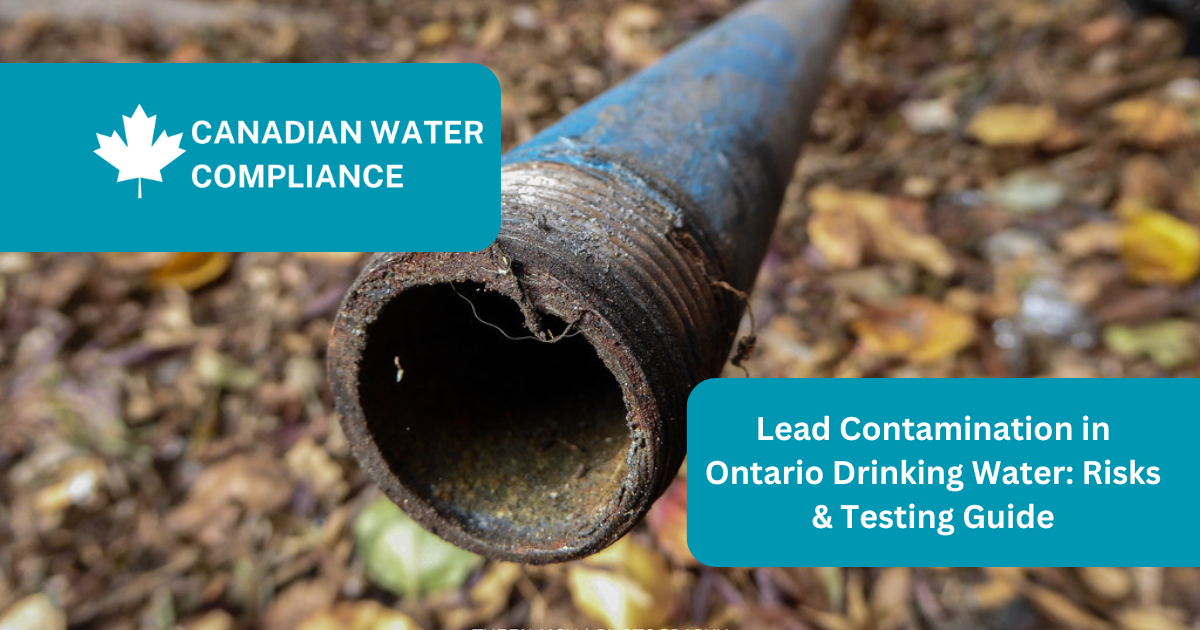
Written By: Canadian Water Compliance | On
Lead contamination in drinking water remains a serious health concern in Ontario, particularly in older homes, schools, and childcare facilities. Lead can leach into water from aging infrastructure, old plumbing materials, and lead-based solder, creating potentially dangerous exposure levels—especially for young children and pregnant women.
While municipalities work to reduce lead contamination, homeowners and businesses must take additional precautions to ensure their drinking water is safe. This guide will explore:
How lead enters Ontario’s drinking water
Health risks associated with lead exposure
Ontario’s lead testing programs and regulations
How to reduce or eliminate lead from drinking water
Unlike bacteria or other contaminants, lead does not naturally occur in water sources. Instead, it typically enters drinking water through human-made materials, particularly in older infrastructure. The most common sources include:
🔹 Lead Service Lines – Some homes built before the 1950s may still have lead pipes connecting them to municipal water supplies. These pipes can leach lead into the water as they corrode.
🔹 Plumbing Materials & Fixtures – Lead-based solder was commonly used in plumbing systems before 1990. Even brass or chrome-plated faucets and fixtures may contain trace amounts of lead.
🔹 Corrosion of Older Pipes – Water with low pH levels (acidic water) or high mineral content can accelerate pipe corrosion, increasing lead leaching into the water supply.
🔹 Stagnant Water in Pipes – Water that sits in lead-containing pipes for extended periods is more likely to absorb lead, making the first draw of water in the morning the most contaminated.
Lead is a toxic metal with no safe level of exposure, according to Health Canada and the World Health Organization (WHO). Even small amounts of lead can accumulate in the body over time, causing significant health issues.
🚼 Infants & Children: Lead exposure in early development can result in learning disabilities, reduced IQ, behavioral issues, and developmental delays.
🤰 Pregnant Women: Lead can pass from mother to fetus, increasing the risk of premature birth, low birth weight, and developmental problems.
👨🦳 Adults: Long-term exposure to lead has been linked to high blood pressure, kidney damage, and neurological disorders.
To combat lead contamination, Ontario has implemented strict testing and treatment requirements, particularly for high-risk locations like schools, daycare centers, and older residential areas.
✅ The Ontario standard for lead in drinking water is 5 parts per billion (ppb), reduced from the previous limit of 10 ppb in 2019 to align with updated health recommendations.
✅ Schools & Childcare Facilities: Ontario mandates regular lead testing in schools and childcare centers. If lead levels exceed 5 ppb, corrective action must be taken, including flushing pipes or installing filtration systems.
✅ Municipal Water Testing Programs: Many Ontario municipalities, including Toronto, Ottawa, and Hamilton, offer free lead testing programs for homeowners concerned about their drinking water quality.
✅ Homeowners with Private Wells: Lead testing is not included in standard well water testing, but private well owners should conduct annual testing for lead if their home has older plumbing materials.
If you suspect your drinking water contains lead, testing is the only way to confirm contamination levels. Here’s how you can test your water:
🔬 Municipal Lead Testing Programs – Many Ontario cities offer free or low-cost lead testing for residents. Contact your local public health unit or municipal water provider for details.
🔬 Laboratory Testing – Homeowners and businesses can send water samples to an accredited drinking water laboratory for lead analysis.
🔬 DIY Lead Test Kits – Available at hardware stores, these kits provide initial lead level detection but may not be as precise as professional lab tests.
🔬 “First Draw” & “Flushed” Water Samples – Water samples should be taken after water has been stagnant for at least 6 hours and after a few minutes of flushing to assess lead leaching.
If lead is detected in your water, several treatment methods can reduce or eliminate exposure:
💧 Flushing Your Pipes – Run cold water for at least 5 minutes before using it for drinking or cooking, especially if the water has been sitting overnight.
💧 Installing Certified Lead Filters – Use NSF/ANSI Standard 53 or 58-certified water filters to effectively remove lead from drinking water.
💧 Replacing Lead Service Lines – If your home has a lead service line, contact your municipality about replacement programs. Some cities offer partial or full lead pipe replacement assistance.
💧 Using Cold Water for Drinking & Cooking – Hot water can dissolve lead more easily, so always use cold, filtered water for drinking and cooking.
💧 Regular Water Testing – Test your water at least once a year if your home has older plumbing or if you’re unsure of lead risks.
Lead contamination in drinking water remains a serious public health issue in Ontario, particularly in older buildings and communities with aging infrastructure. Testing is crucial to ensure your water is safe, and if lead is present, effective filtration and replacement solutions can minimize exposure.
🏡 Homeowners & renters: Contact your municipality for lead testing services.
🏢 Businesses & childcare facilities: Follow Ontario’s lead testing regulations to protect your staff and visitors.
📢 Take Action: If you’re concerned about lead in your drinking water, schedule a test today and explore the best filtration options for your home or business.